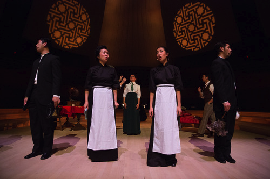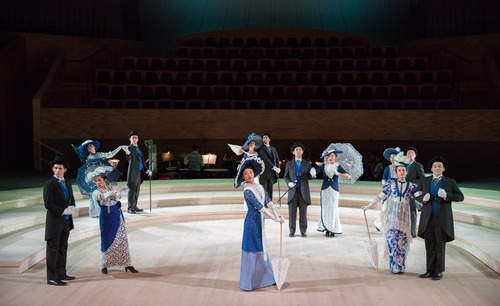
I did not ask for identity politics. I showed up at the dress rehearsal for My Fair Lady at Stanford’s Memorial Auditorium expecting a young actress to show me what she could do with her vibrato.
Instead, director Ken Savage’s production exploded from the stage and captured my mind and soul, awakening within me an aptitude for acute recognition. I was subsumed, following a social commentary I had never seen My Fair Lady as capable of providing. I leaned into my seat as this story of British Asian immigrants unraveled in front of me, featuring characters whose racial identity informs their actions as much as it troubles them: the young woman who needs to reinvent her own language to fake her way to the top, the arrogant phonetics professor who agrees to teach her to amuse himself, the old white colonel who brings down the tension between them by ten notches, and a father on the social climb who manages to get the best out of everybody.
This production of My Fair Lady is staged by the Asian American Theatre Project (AATP), and Stanford’s Department of Theatre and Performance Studies (TAPS). AATP’s focus is on increasing the representation of Asians and Asian Americans in theatre arts. In this case, the student-artists of AATP decided to reinvent theatre instead of merely staging it, by selecting a production that usually features white actors, and rebuilding it with a predominantly Asian cast –each member trained in their own slang of British English.
Asia Chiao’s costumes work strongly in favor of foregrounding the British Asian immigrant experience. Drawing on blue and white as the colors of Chinese porcelain –illustrating a tension between the import of porcelain into Britain and the concomitant colonial attitudes towards China from the British – Chiao employs uniformity to establish a collectivist spirit among characters who work together, while dressing eccentrics completely differently. As the show draws closer to its spectacular finale, we see Eliza Doolittle’s fashion shift from traditionally Asian to Caucasian, thereby adding a new layer to the debate on identity and representation. One wonders if the casting of Saya Jenks (who identifies as half Asian and half white) as Eliza Doolittle is done with these intentions in mind, inviting a discussion on mixed race people, and how the immigrant experience affects them.
Outside of the discussion on race and ethnicity, Savage’s production features impressive acting and singing talent. Max Savage’s stern performance is exceptional; from genial bullying, which allows Savage’s frat boy to come out and play, to stormy petulance, which bursts out onstage when Eliza Doolittle acts against his will. Playing Eliza with a grace that never quite takes itself too seriously, Saya Jenks proves herself as a worthy inheritor of Julie Andrews. Additionally, Sarah Jiang’s performance as Higgins’ socialite mother, and Weston Gaylord’s acting as Colonel Pickering easily commit themselves to memory. When her character’s son is left by Eliza, and asks for advice on what to do, Jiang’s “Do without, I suppose.” is as passive-aggressive as it is didactic - leveraging her limited stage presence, she reminds that flat characters need not stay flat, if played to their fullest extent.
Dance is where My Fair Lady seems to struggle the most. Aside from a passionately executed waltz scene between Savage and Jenks, most of the choreography seems a little too choppy to the inexperienced eye. Moreover, while we applaud AATP for staging the first-ever student production at Bing Concert Hall, we must also ask what kind of politics may have prevented Stanford’s Department of Theatre and Performance Studies from securing a space more amenable to this piece (the charming Piggott Theater comes to mind.) This may have afforded My Fair Lady a longer run, granting more members of the Stanford community the chance to experience this extraordinary production.
From its questions of ethnicity to the problematic choice of performance space, My Fair Lady abounds in politics. As such, it stands as a form of scholarly activism –an invitation to start a dialogue on how we perceive characters when they belong to a given race, and why we do not perceive them in that way when they belong to another one. Furthermore, its activism shows us that passionate students need to navigate the power dynamics of academia to arrive at a satisfying outlet for their art. Finally, it must invite us to keep posing the questions: is there only one way for politics to impact art, or is the artistic continuously in a conversation with the political, never ceasing to agitate, astonish, and absorb?

